Telemedicine applications change the delivery of traditional healthcare, often making services available to people who previously couldn’t access them. But should you consider building such an application? And if yes, what’s the best way to approach the process?
This article is your roadmap to understanding the value of telehealth applications, the essential steps to successfully develop one, and key challenges your development team may face along the way.
Whether you’re a healthcare provider aiming to improve patient outcomes or a telehealth app vendor seeking to create a successful new product, this telemedicine app development guide will help you navigate the complexities of building a robust, secure, and scalable telehealth solution.
Contents:
- Why the healthcare industry needs telehealth apps
- Common types of telemedicine apps
- Core features of a telemedicine app
- Emerging trends in telemedicine app development
- How to develop a telemedicine app
- Challenges in developing a successful telemedicine app
- How can Apriorit help you build your telehealth app?
- Conclusion
Why the healthcare industry needs telehealth apps
Telehealth or telemedicine applications are dedicated software solutions designed to enable the remote delivery of clinical medical services. These apps are often used to provide consultations, diagnostics, and patient monitoring as well as non-clinical services like health education or provider training.
Telehealth solutions usually rely on various devices equipped with microphones and cameras for voice and video calls, enabling real-time communication and thus bridging the gap between healthcare providers and their patients.
They also can support asynchronous communication via chatbots and messengers, allowing healthcare professionals and their patients to exchange text messages and photos with health updates, lab tests, and prescriptions.
Recognizing the potential of telehealth applications, both healthcare service providers and medical software vendors are increasing their investments in this segment. In fact, MarketsandMarkets forecasts that the telehealth market will grow, reaching as high as $285.7 billion by 2028 compared to $120.4 billion in 2023.
If you are considering investing in building such a solution, now seems to be the perfect time. Especially considering the benefits these applications can bring to both healthcare providers and their patients.
Ready to build a custom telehealth solution?
Enhance your project team with Apriorit’s outstanding industry expertise and top talents to ensure the delivery of a secure, reliable, and competitive product.
Benefits of telemedicine apps
Telehealth software solutions bring meaningful benefits to both patients and healthcare providers, improving the quality, flexibility, and accessibility of healthcare services.
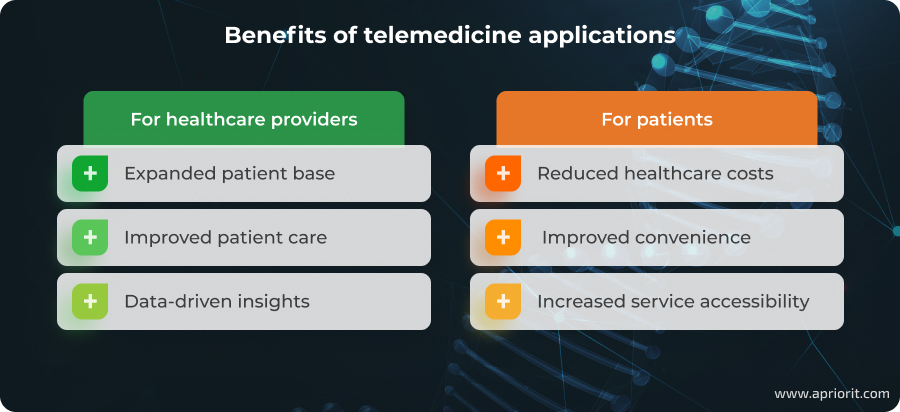
On the provider’s side, telehealth applications enable:
1. Operational efficiency — Automating various healthcare operations like appointment scheduling and payment processing, telehealth applications help to reduce administrative overhead, allowing healthcare providers to focus more on patient care.
2. Expanded patient base — Even though telehealth apps require access to the internet and use advanced technologies, they make healthcare services more inclusive. In particular, healthcare providers can deliver their services to underserved communities, people from rural areas, and people with limited mobility.
3. Improved patient care — With telemedicine, healthcare professionals can provide better care to their patients by regularly monitoring their progress and intervening in a timely manner. This is particularly valuable when providing mental health care, delivering post-operative follow-ups, or working with patients with chronic diseases.
4. Data-driven insights — Telemedicine solutions enable data-driven patient care, collecting and processing extensive data on patients and their treatments. Such solutions can also be used to analyze the efficiency of healthcare processes and workflows, allowing organizations to make informed decisions, enhance treatment protocols, and improve the overall quality of their services.
On the patient side, telemedicine apps also bring multiple benefits, creating a more convenient and cost-effective healthcare experience with reduced wait times and increased accessibility of healthcare services.
Today’s market offers various types of telehealth solutions that can assist healthcare professionals with one or multiple tasks. In the next section, we take a closer look at the most commonly used types of telemedicine apps.
Read also
Benefits of AI in Healthcare: How to Enhance Your Software and Improve Patient Care
From predictive analytics to personalized treatments, see how AI transforms healthcare delivery and explore the most common practical applications of AI for medical professionals.

Common types of telemedicine apps
While there are all kinds of telemedicine apps on the market, these are the most common:
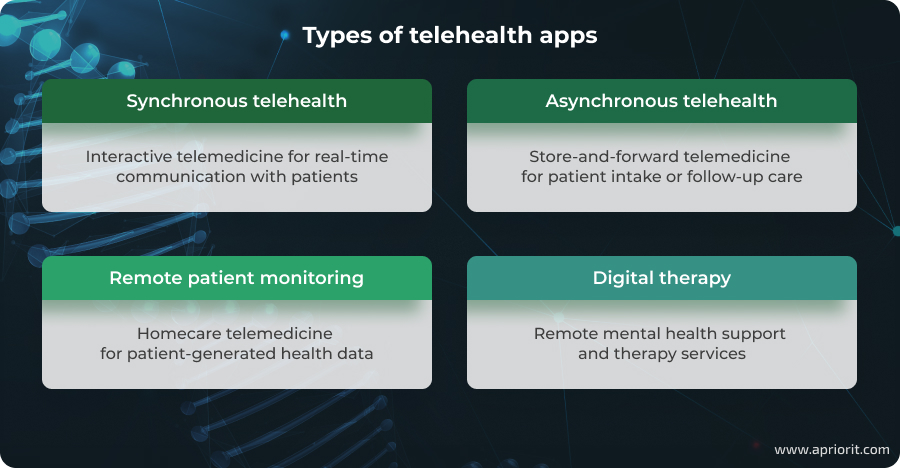
Let’s look closer at each of these types.
1. Synchronous telehealth
Interactive telemedicine enables real-time communication between healthcare professionals and patients, usually via phone or video calls. This type of telemedicine application can be used for both planned and emergency contact with healthcare providers.
You can use synchronous telehealth apps to:
- Expand healthcare accessibility
- Shorten wait times
- Improve patient–provider communication
2. Asynchronous telehealth
Often referred to as store-and-forward telemedicine, asynchronous telehealth solutions are often used to transfer text, medical images, audio, and other data. These apps allow for healthcare data exchange between healthcare providers and their patients when real-time interactions are unnecessary. Common use cases for asynchronous telehealth apps include remote healthcare consulting, reviewing lab results, renewing prescriptions, and providing support or health education.
You can use asynchronous telehealth apps to:
- Streamline healthcare workflows
- Reduce healthcare service costs
- Increase healthcare accessibility
- Improve healthcare service convenience
3. Remote patient monitoring
Remote patient monitoring (RPM) applications often rely on wearable devices such as smartwatches and heart monitors to collect and transfer essential health data to device applications and then to a cloud-based telemedicine server. Healthcare providers, remote nursing services, and even patients can use such solutions to measure, monitor, and analyze vital healthcare data. The most common use cases for RPM solutions include managing chronic conditions like diabetes or cardiovascular disease and monitoring recently discharged patients.
You can use remote patient monitoring apps to:
- Enable early detection of health changes
- Improve chronic disease management
- Reduce hospital load and readmissions
4. Digital therapy apps
Dedicated mental health telemedicine apps create a safe and convenient environment for delivering therapy services to patients. They can be used as a supporting tool or an online alternative to in-person therapy. Common use cases for such applications include personal therapy, support groups, and self-assessment.
You can use digital therapy apps to:
- Expand therapy accessibility
- Reduce therapy costs
- Increase patient engagement and self-care
This classification is rather schematic, as some telehealth features will be the same for all these application categories while others will be unique to specific types. You can combine features common for different types of telehealth solutions in one application and add support for both desktop and mobile platforms. In this way, you can expand the patient base and make healthcare services more accessible while reducing their costs and administrative overhead.
In the next section, we analyze core features to consider for your custom telehealth application.
Read also
How to Build an EHR System with SaaS: Trends, Challenges, and Prospects
Get expert advice on developing SaaS-based EHR systems. Discover solutions for meeting compliance, ensuring security, and designing scalable healthcare systems.

Core features of a telemedicine app
The choice of a fitting feature set will depend on the type and goals of the telemedicine app you want to build. We can outline three general categories of telehealth app features:
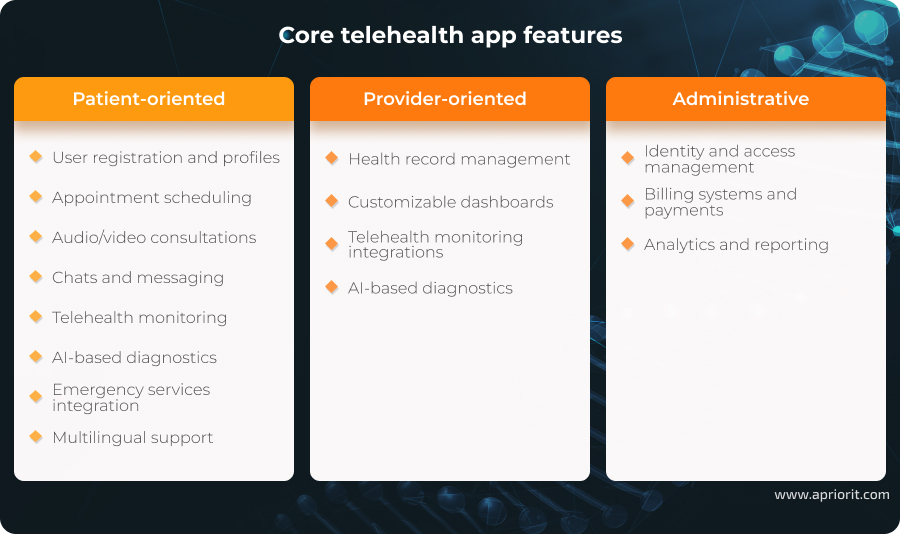
Patient-oriented features
Telehealth features oriented at patients prioritize service accessibility, convenience, and patient engagement. Here are some commonly used patient-oriented features to include in your app:
- User registration and profiles to enable patients to register personal accounts, share their medical information, and securely store their medical history.
- Appointment scheduling so patients can manage their appointments. Common functionality includes booking, rescheduling, and canceling appointments as well as setting reminders and notifications.
- Audio and video consultations to deliver real-time healthcare services to patients remotely. For this functionality, it’s crucial to ensure seamless application performance with high-quality video and audio streams.
- Chat and messaging for secure exchange of text, images, video, and audio records.
- Telehealth monitoring to track and monitor vital health data in real time, such as glucose levels, heart rate, and blood pressure, leveraging integrations with IoT devices.
- AI-based diagnostics to enable preliminary health assessments and remote consultations, reducing the number of unnecessary doctor visits.
- Emergency services integration to enable patients to quickly connect with emergency services and increase patient safety.
- Multilingual support to eliminate language barriers between healthcare providers and patients.
Provider-oriented features
These features aim to streamline workflows, enhance patient care, and improve decision-making for healthcare professionals:
- Health record management features to provide healthcare professionals with easy and safe access to patient profiles, lab results, and treatment plans for personalized, timely care. Usually, these features require integration with EHR/EMR systems for a secure and seamless data flow.
- Customizable dashboards to help healthcare specialists manage their schedules, review patient data, and track performance metrics efficiently.
- Telehealth monitoring integrations to provide healthcare professionals with access to live patient data from wearables or sensors, thus automating and improving patient state assessment and analysis for preparing treatment plans.
- AI-based diagnostics to optimize patient symptom analysis and extract data-driven insights for improved diagnostic accuracy.
Administrative features
The administrative side of telehealth apps is crucial to ensuring seamless operation and full compliance with relevant regulatory requirements. These features commonly focus on managing system users, data, and finances:
- Identity and access management to ensure that only authorized users can access sensitive information, including personal patient information, medical records, and insurance data. These features are essential for complying with the requirements of HIPAA, the NHS, and the GDPR.
- Billing systems and payments to automate and optimize payment transactions. They usually require integration with multiple payment options like credit cards and insurance claims.
- Analytics and reporting for efficient, automated assessment of system performance, user activity, revenue, etc. Such features often require implementing interactive dashboards for better data visualization and to support data-driven decision-making.
Implementing these features can help you build a robust and competitive telehealth application. However, you need to account for the target audience and the goals of the product you want to deliver. For a patient-focused application, for instance, you may want to prioritize various user engagement tools. In turn, for a solution targeting healthcare providers, it will be more useful to invest in features that aim to streamline operational workflows and enable advanced diagnostic capabilities.
Read also
HIPAA Compliance Checklist for Healthcare Software
Ensure your software is HIPAA-ready. Learn how QA practices can help you meet HIPAA compliance requirements and secure sensitive healthcare data.
Emerging trends in telemedicine app development
When planning your custom telehealth app development, consider the following trends in advanced technologies and services:
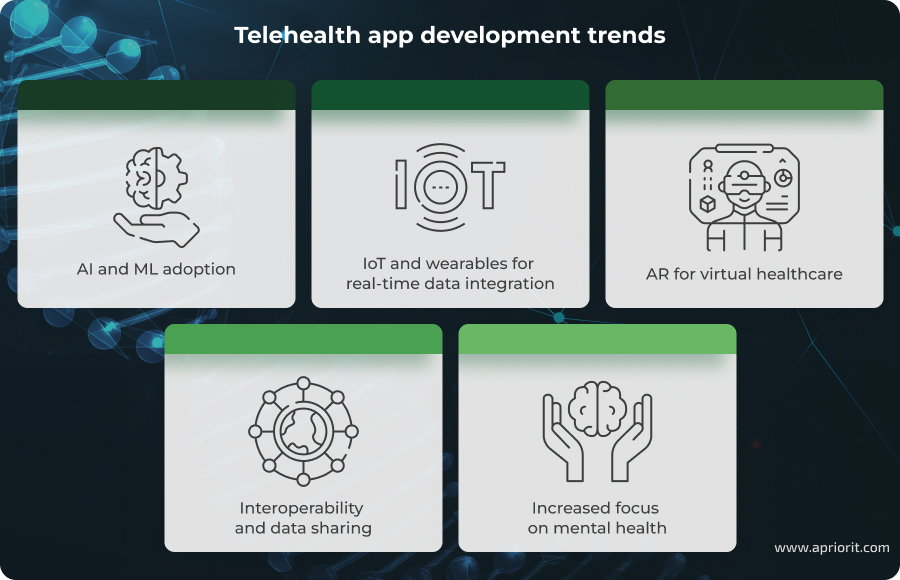
AI and ML adoption
The capabilities enabled by artificial intelligence (AI) and machine learning (ML) are drastically shaping the evolution of the telehealth app market.
On the patient side, AI-powered chatbots and virtual healthcare assistants enable real-time access to medical recommendations even when there’s no immediate access to a healthcare facility and human professionals. AI-powered analytics, in turn, enables healthcare professionals to increase their productivity while also improving diagnostic accuracy.
The use of ML algorithms, on the other hand, allows for advanced personalization of healthcare services and data-driven decision-making.
Read also
Building an AI-based Healthcare Solution
See how Apriorit helped a healthcare service provider employ AI algorithms and achieve 90% precision in diagnostics to accelerate and simplify doctors’ routines while delivering high-quality services to their patients.
IoT and wearables for real-time data integration
With the rising adoption of 5G-enabled connectivity and advanced IoT devices, adding support for healthcare wearables has become not just a trend but a necessity for today’s telehealth applications.
IoT healthcare devices are especially important for RPM solutions. Wearables and advanced data exchange technologies enable real-time collection and analysis of vital health metrics, allowing healthcare professionals to monitor their patients and provide timely adjustments to their care plans.
Augmented reality (AR) for virtual healthcare
With AR-powered capabilities, healthcare providers can better visualize patients’ symptoms during virtual consultations, increasing diagnostic accuracy. AR-powered capabilities can also be helpful for remote rehabilitation, guiding patients through self-assessments and exercises.
Interoperability and data sharing
The amount of data generated and processed by telehealth applications keeps rising. And it’s only natural that the need for fast and safe data sharing and integration with dedicated healthcare platforms also increases from year to year.
Integrations and real-time data exchange are crucial for accurate diagnostics, timely treatment adjustments, and ongoing patient support. Usually, this is achieved through adopting advanced data exchange protocols and API implementations.
Increased focus on mental health
With the rising demand for mental health support, the telehealth app market sees an increase in dedicated products for remote therapy, counseling, and self-care. Such dedicated solutions enable patients to search for and connect withtherapists who meet highly personalized criteria. Usually, telehealth therapy apps offer capabilities like virtual therapy sessions, messaging, self-assessment, and self-care tools.
Read also
Top Healthcare IT Trends to Watch in 2025
Discover the latest trends transforming the healthcare industry, from AI to IoT, and learn how to leverage them effectively in your next healthcare project.
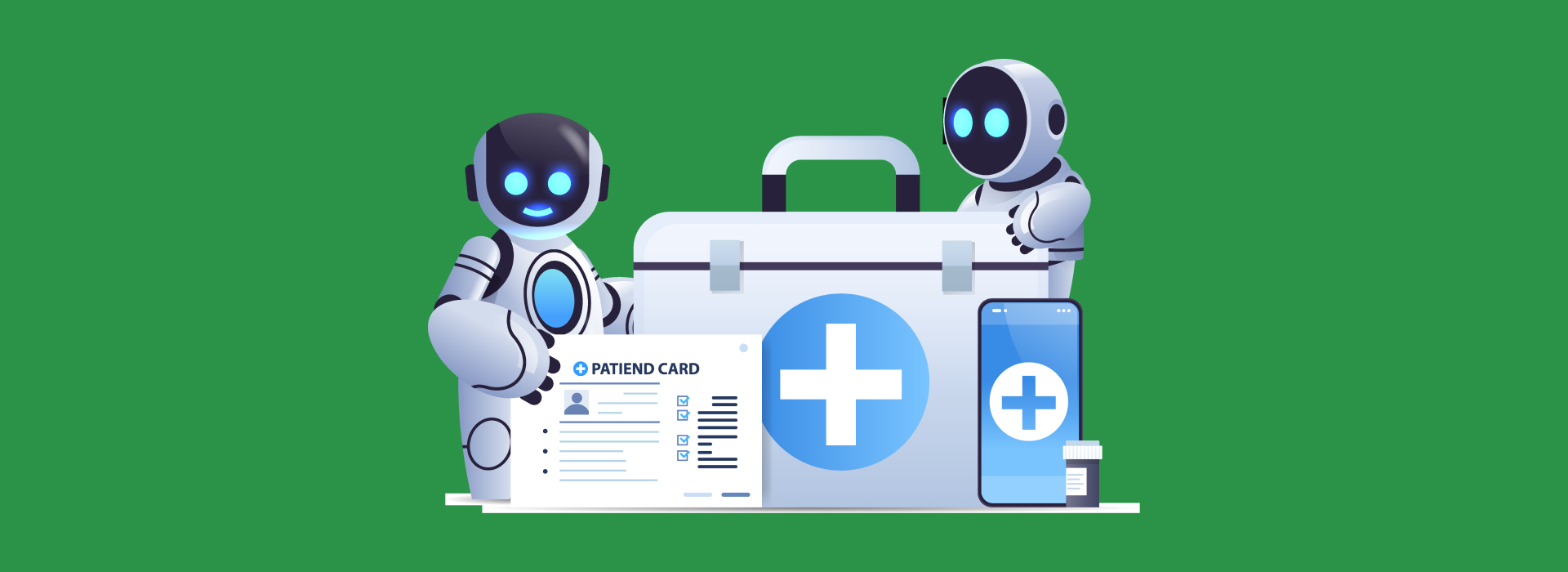
How to develop a telemedicine app
Depending on the type of solution you want to build and the feature set you want it to include, you may need to adjust your development process. However, the core steps will remain the same for most applications. Let’s take a look:
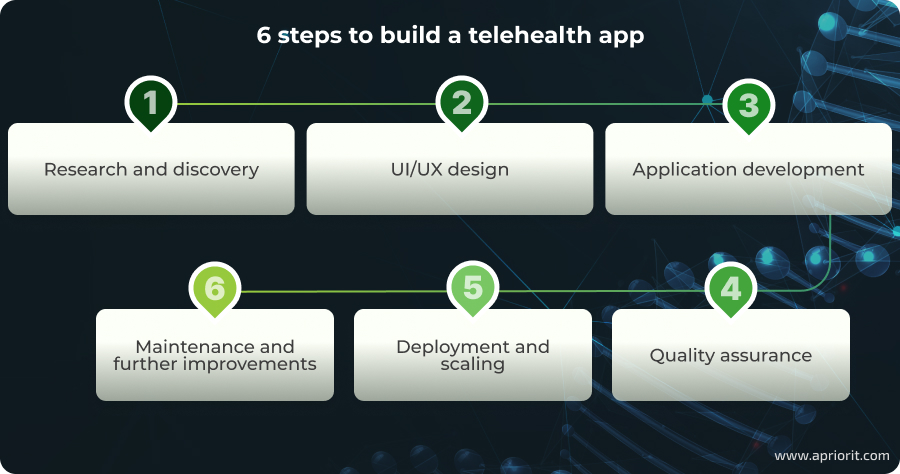
1. Research and discovery
Before your development team starts writing any code, you need to set clear expectations for the product you want to create and turn them into detailed technical requirements for your team to follow.
At the research and discovery stage, you may need assistance from experienced business analysts who can analyze the current market, look into your competitors, define security requirements, and help you figure out the best way to align your vision with your team’s technical skills and your estimated budget.
2. UI/UX design
Even the most helpful product won’t gain user affection if it has an unresponsive interface and a poor user experience. That’s why your team needs to start planning your application’s interface and refine the user experience early on.
Ideally, your team will need to review your competition, design detailed customer journey maps, and come up with several possible design approaches to make sure that your product will be competitive and meet the needs of your end users.
3. Application development
Once you have all the technical details and design vision sorted out, your team can start the actual development process. Depending on the specifics of your project, you may start with a small MVP or go for a full-scale solution right away.
While implementing various features of your future telehealth app, different members of your development team will need to continually communicate and synchronize with each other to maintain the desired level of application performance, scaling, integrability, and security. Having an experienced project manager on the team will help you establish and enhance all in-project processes and keep team communication smooth and productive.
Read also
Outsourcing Project Management: Concerns, Advantages, and Our Approach
Explore the benefits of outsourcing your project management tasks to experts and learn how Apriorit PMs achieve better results with less effort.
4. Quality assurance
Thorough quality assurance is essential to delivering a reliable, secure, and competitive product. Your team will need to design and execute a set of functional, usability, and security tests to evaluate the developed product and determine what can and should be improved in it.
As telehealth applications must comply with various healthcare laws and regulations, you’ll need to make sure that your app meets HIPAA, NHS, and other requirements. In particular, your team will need to pay special attention to user data privacy, data exchange, and storage security. You may also need to obtain special certifications before launching your application.
5. Deployment and scaling
Once all features are implemented and properly tested, you can deploy and launch your telehealth app. At this stage, it’s important to closely monitor the performance of your application and process user feedback to detect and address possible issues in a timely manner.
6. Maintenance and further improvements
Even after your application is up and running, your development team will need to keep improving it with timely fixes, new features, and technical support to the application’s end users. This will help you ensure that your application meets users’ demands and stays competitive.
Related project
Improving a SaaS Cybersecurity Platform with Competitive Features and Quality Maintenance
See how Apriorit’s team addressed critical cybersecurity gaps in a SaaS platform, delivering a secure and efficient solution that enhanced user trust and business operations.

Challenges in developing a successful telemedicine app
As your team works on building and deploying a telehealth application, multiple challenges may arise. Let’s discuss the most common:
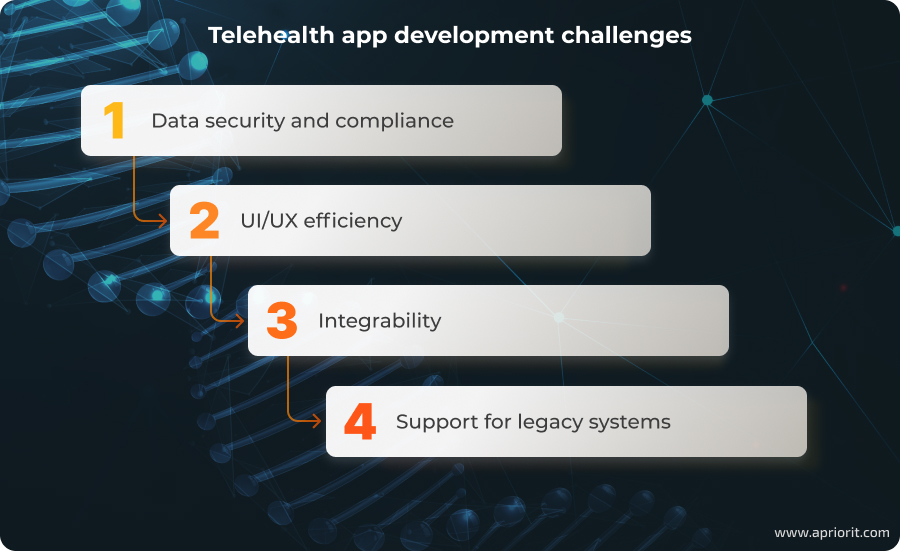
1. Data security and compliance
Healthcare is one of the most strictly regulated industries, as it handles vast volumes of sensitive personal and medical data. Therefore, building a secure and compliant telehealth application can become a real challenge.
Depending on the region you want your telehealth app to operate in, you’ll need to meet the requirements of HIPAA and the HITECH Act ((US), the NHS (UK), the GDPR (EU), and so on.
Make sure to determine the regulations and standards you need to comply with as early as possible and implement their requirements into your telemedicine app development roadmap.
2. UI/UX efficiency
A successful and competitive telehealth application must be easy to use, responsive, and compatible with at least the most common operating systems and devices. As one of the main goals of telehealth products is to increase healthcare accessibility, it’s also vital to make sure that your application is inclusive and can be comfortably used by individuals with limited physical capabilities.
For example, you may want to consider implementing text-to-speech generators or supporting assistive devices like screen readers and braille keyboards for people with disabilities.
3. Integrability
To make sure that your telehealth app delivers an ultimate experience to healthcare professionals, it should be easy to integrate with EHR/EMR management systems and healthcare platforms commonly used by healthcare organizations in your target region. This integration must be not only flawless in terms of performance and real-time data exchange but also highly secure.
4. Support for legacy systems
While advanced and innovative technologies make their way into healthcare services, the healthcare industry also relies heavily on complex legacy systems. These can include EHR management platforms, administration and payment systems, medical devices, and communication networks. Legacy systems are often difficult to adapt to and integrate with, making it even more challenging to meet regulatory requirements and patient needs and support continually changing clinical workflows. Therefore, it’s important to determine and account for the legacy systems you want your application to be compatible with as early as possible.
How can Apriorit help you build your telehealth app?
Creating a custom telehealth app is a non-trivial task that only a highly experienced telehealth app development company can handle. Apriorit will help you create an application that meets ever-changing customer demands, complies with relevant industry and security standards, and supports both innovative technologies and legacy systems.
With over 20 years of experience in the field and outstanding cybersecurity expertise, Apriorit can equip you with a dedicated team composed of such professionals. By partnering with us, you get access to:
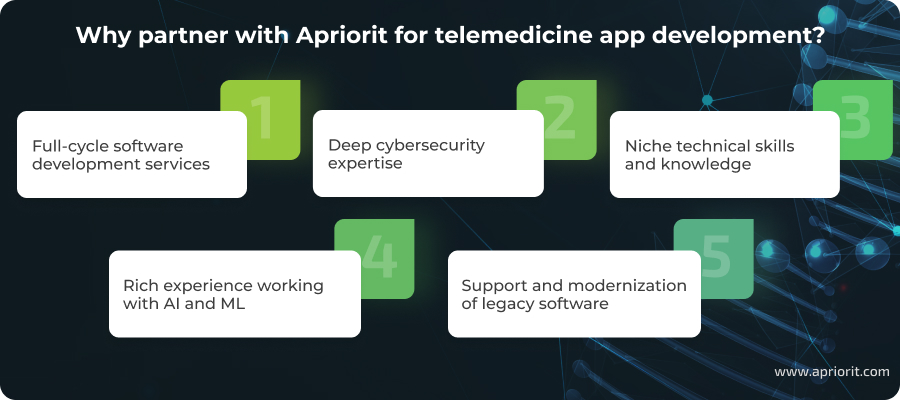
1. Full-cycle software development services — From research and discovery to development, testing, post-release maintenance, and support, Apriorit can provide you with the exact assistance you need at the moment. You can delegate to us the complete process of designing, building, and deploying your telehealth application, or you can involve our team at specific stages where you need expert assistance.
2. Deep cybersecurity expertise — Cybersecurity is our focus in every project. Following secure SDLC principles, we not only deliver highly secure custom software but also make sure to build it in a secure, regulatory-compliant manner.
3. Niche technical skills and knowledge — To deliver a successful telehealth application, you’ll need niche expertise in various fields, from IoT and embedded systems to kernel and driver development to reverse engineering. At Apriorit, you can find top-level professionals for the most challenging technical tasks, from reversing a legacy IoT device in order to solve compatibility issues to building a custom driver for your own wearable device.
4. Rich experience working with AI and ML — Aprioit’s experience in the AI field ranges from designing custom training datasets and expanding them with synthetic data to building custom machine learning algorithms and fine-tuning AI models for specific healthcare tasks. We know how to optimize AI performance while ensuring top-level data security and protection. Our team can also assist you with implementing generative AI technologies and building custom AI chatbots for your telehealth solution.
5. Support and modernization of legacy software — Apriorit specialists know how to maintain legacy systems and introduce upgrades in a way that doesn’t interfere with the service’s operation. We can help you with refactoring code, migrating to a new platform, implementing new features, and more.
Conclusion
Telehealth applications are on the rise, helping healthcare providers make their services more accessible and convenient for larger groups of patients. Developing a custom telehealth application is a challenging task that requires a deep understanding of the market, niche technical expertise, and thorough planning of the development and maintenance processes.
By outsourcing the creation of your telemedicine app to a professional healthcare software development company like Apriorit, you get a reliable partner to help you with the most challenging stages of this process. Get in touch with us to discuss the most fitting cooperation models and implementation strategies to turn your telehealth idea into a secure, efficient, and competitive product.
Want to accelerate your telemedicine software development?
Apriorit’s dedicated teams deliver custom software and application solutions that will exceed your expectations. Partner with us for a seamless and innovative telehealth experience.


